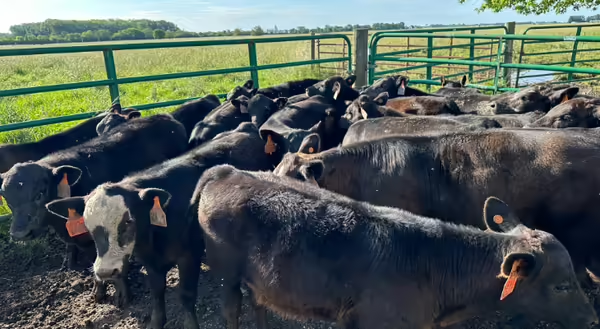
Weaning is one of the most stressful times in a calf’s life. The stress that occurs at weaning can negatively affect early performance post-weaning, whether that be on the pasture or in the feed yard. We want our cattle to have a positive start as they enter the feeder phase, and that all starts with weaning. Regardless if you’re early weaning or normal weaning, reducing stressors pre and post weaning allows calves better chances to thrive as they move into adulthood.
Two Step Weaning
Two step weaning involves the use of nose flaps. Calves are separated from their mothers and ring-like flaps are placed tightly on their nasal septum. Some flaps have prongs protruding that prevent the calf from nursing, others are flat. After securing their new hardware, the calves are then turned back out with their dams for 4-7 days. After those few days the nose flaps are removed, and the calves are either shipped out or taken to another pasture or feedlot.
Fence Line Weaning
Another method of weaning is fence line weaning. This requires calves to be separated from their dams and placed in a lot or pasture on a separate side of the fence. Before separating the calves, make sure your fence is strong and in good condition. It can be beneficial to have 4-5 stands of Hi-Tensile or barbed wire with an electric wire. The calves can still see, hear, and smell their mom’s, but the fence between them prevents suckling. Strategically placing waterers and feed on the fence line ensures the cattle have easy access to food and water. A cull cow or yearling could also be placed with the calves to reduce stress. After a few days, the cows and calves will likely move farther from the fence line and become less interested in each other.
Hard Weaning
Hard weaning is when the calves are separated from their mothers and shipped out on the same day. This consolidates what could be a few stressful workings to just one big event. Abrupt weaning lowers input costs and requires less handling than other weaning methods.
Tips
Spreading out events like weaning, castration, shipping, and vaccinations can help to reduce the amount of stress calves feel. Technologies like Lidoband, a castration band made with lidocaine, help reduce pain and stress. Vaccinating 2-3 weeks before weaning allows time for the cattle to build immunity before shipping. Adequate mineral supplementation can also contribute to increased immune system function. Introducing new feeds before weaning helps to acclimate calves before they move to the feedlot. Being acclimated to the feed can help calves to start eating more quickly post-weaning. Using pheromones can also help to calm calves. Products like FerAppease use a synthetic version of Bovine Appeasing Substance (mBAS). mBAS is substance that is secreted naturally by the mammary gland. By topically applying this product behind the poll and on the bridge of the nose we are effectively able to simulate the scent of their mothers, which leads to reduced cortisol levels.
Summary
Stress around the time of weaning can reduce feed intake as calves move to the feedlot. Giving animals the best start in the feeder phase requires the use of tactics that reduce stress felt by cattle. Decreased stress at weaning has been shown to increase weight gain post-weaning, and low stress means quieter calves and happier farmers.
About the Author
Mabry Bruhn is a student at the University of Illinois Urbana-Champaign who works in beef production, research, and producer outreach as a University of Illinois Extension intern in the I-BELIEF program through the Department of Animal Sciences in the College of Agricultural, Consumer and Environmental Sciences. This article has been reviewed by Extension Commercial Agriculture Educator, Travis Meteer.